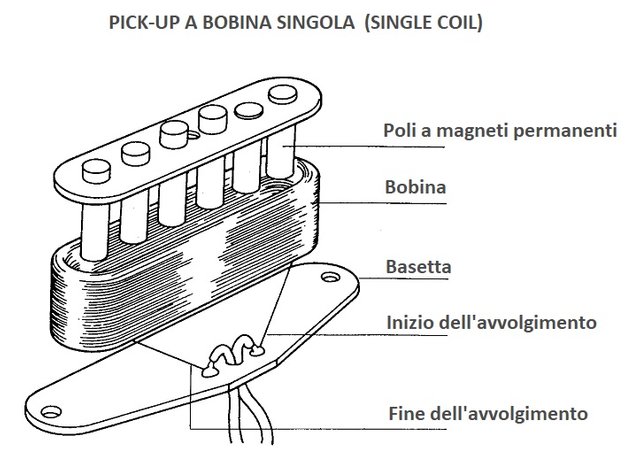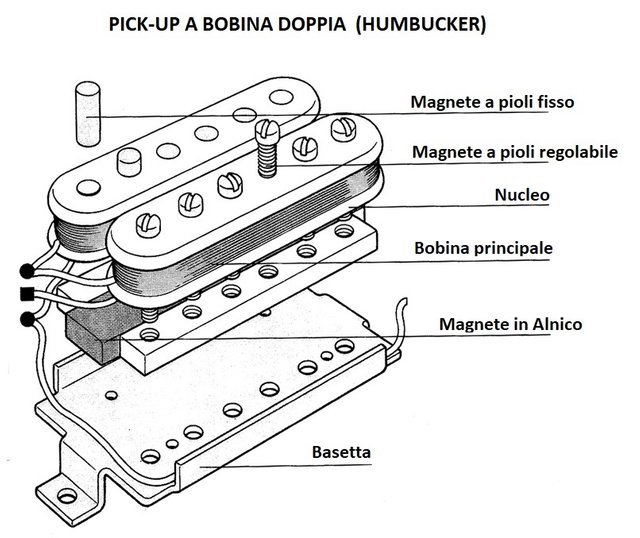Electric guitar pick-ups / I pick-up nelle chitarre elettriche
Electric guitar pick-ups
Steemians friends well found for a new chapter #stemsunday on electric guitars.
This time we talk about pickups, the magnets that "fan" our guitar.
They are nothing but electromagnetic coils or transducers that transform physical energy into electricity. The physical energy in this case is given by the vibrating action of the strings that is converted into electrical impulses subsequently conveyed in an amplifier to turn them into sound audible by the loudspeaker.
The electric guitars can be fitted with one to three types of pick-up, with a single coil (single coil) or with a double coil (humbucker) selectable in operation through a special selector generally from three to five positions. Using the volume and tone potentiometers, the sound can be varied.
We can distinguish the pick-ups in three functions: rhythmic, central, solo. The rhythmic is that placed near the handle and is characterized by a softer sound than the others.
The central is generally a middle of the two extremes while the soloist who is positioned near the bridge, has a brilliant and metallic sound.
- Single coil pick-ups are composed of a copper coil winding around an Alnico core or of six different peg magnets scaled between them to improve the level equalization of the strings. The shape of the magnet (s) varies depending on the design of the pick-up. The stronger the magnets, the more powerful the amplified sound will be; however it must be considered that too powerful magnets can stop the strings too soon causing sustained fall and timbre distortion.

- The Humbucker Pickups are double coil magnets connected in series out of phase and their name derives from * humbucking * (buzz compensation) since all electromagnets are subject to picking up hum or noise from other electric devices placed nearby.
Connecting dune coils in this way, the current flows through the coils first in one and then in the other so any interference picked up is sent from a coil as a positive signal and from the other as negative, canceling each other out. To ensure that the current flowing in opposite directions does not also cancel the vibrations of the strings, the poles of the Humbucker pick-ups have opposite magnetic polarities so when the secondary coil reverses the signal of the disturbed magnetic field, instead of canceling the electric impulse generated by the strings, it duplicates it. This type of pickup not only attenuates the interference a lot but has a distinctly different sound from the previous pick-up we have seen (single coil) since the double coil causes a lower sound definition and therefore a lower response on the high frequencies enhancing a warmer and fuller sound.

Clearly it is possible to replace the pick-ups on each guitar, both of different types and of the same type but of better quality, creating different combinations until a personalized sound is found. In the next chapter we will see how to replace pickups with a Stratocaster type guitar.
Stay tuned ! Ciaooooooooooooo!
I pick-up nelle chitarre elettriche
Amici Steemians ben ritrovati per un nuovo capitolo #stemsunday sulle chitarre elettriche.
Questa volta parliamo dei pick-up, i magneti che "fan suonare" la nostra chitarra.
Essi non sono altro che delle bobine elettromagnetiche o trasduttori che tramutano l'energia fisica in elettrica. L'energia fisica in questo caso è data dall'azione vibrante delle corde che viene convertita in impulsi elettrici successivamente convogliati in un amplificatore per tramutarli in suono udibile dall'altoparlante.
Le chitarre elettriche possono montare da uno a tre tipi di pick-up, a bobina singola (single coil) oppure a bobina doppia (humbucker) selezionabili nel funzionamento tramite un apposito selettore generalmente da tre a cinque posizioni. Tramite i potenziometri del volume e del tono, è possibile variare la sonorità.
I pick-up li possiamo distinguere in tre funzioni: ritmico, centrale, solista. Il ritmico è quello posto vicino al manico ed è caratterizzato da un suono più morbido rispetto agli altri.
Il centrale generalmente è una via di mezzo dei due estremi mentre il solista che è posizionato vicino al ponte, ha un suono brillante e metallico.
- I pick-up single coil sono composti da un avvolgimento a spire di rame attorno ad un nucleo in Alnico oppure a sei diversi magneti a pioli scalati tra di loro per migliorare l'equalizzazione del livello sono delle corde. La forma del o dei magneti varia a seconda del design del pick-up. Più i magneti sono forti, più potente sarà il suono amplificato; tuttavia va considerato che magneti troppo potenti possono arrestare troppo presto le corde provocando caduta di sustain e distorsione timbrica.

- I Pick-up Humbucker sono magneti a doppia bobina collegata in serie fuori fase ed il loro nome deriva da humbucking (compensazione di ronzio) dato che tutti gli elettromagneti sono soggetti a raccogliere ronzii o rumori da altri apparecchi elettrici posti nelle vicinanze.
Collegando dune bobine in questo modo, la corrente attraversa le bobine prima in una e poi nell'altra perciò qualsiasi interferenza captata viene inviata da una bobina come segnale positivo e dall'altra come negativo, annullandosi a vicenda. Per far in modo che la corrente che scorre in direzioni opposte non cancellino anche le vibrazioni delle corde, i poli dei pick-up Humbucker hanno polarità magnetiche opposte quindi quando la bobina secondaria inverte il segnale del campo magnetico disturbato, anzichè cancellare l'impulso elettrico generato dalle corde, lo duplica. Questo tipo di pick.up non solo attenua di molto le interferenze ma ha un suono nettamente diverso dal precedente pick-up che abbiamo visto (single coil) dato che la doppia bobina causa una definizione del suono inferiore e quindi una minore risposta sulle frequenze alte esaltando un suono più caldo e pieno.

Chiaramente è possibile sostituire i pick-up su ogni chitarra, sia di tipo differente, sia dello stesso tipo ma di qualità migliore creando diverse combinazioni fino a trovare un suono personalizzato. Nel prossimo capitolo vedremo come sostituire i pick-up ad una chitarra di tipo Stratocaster.
Restate sintonizzati ! Ciaooooooooooooo !